Fancy pigeon refers to any breed of domestic pigeon, which is a domesticated form of the wild rock dove. They are bred by pigeon fanciers for various traits relating to size, shape, color, and behavior, and often exhibited at pigeon shows, fairs and other livestock exhibits.

The Fantail is a popular breed of fancy pigeon. It is characterised by a fan-shaped tail composed of 30 to 40 feathers, abnormally more than most members of the dove and pigeon family, which usually have 12 to 14 tail feathers. The breed is thought to have originated in Pakistan, India, China, Japan or Spain. There are several subvarieties, such as the English Fantail, the Indian Fantail, and the Thai Fantail. Charles Darwin used it as one of the examples in the first chapter of his book On the Origin of Species. He believed it was a descendant of the rock dove.
The tippler is a breed of domestic pigeon bred to participate in endurance competitions. Flying results of up to 22 hours (non-stop) have been reported.
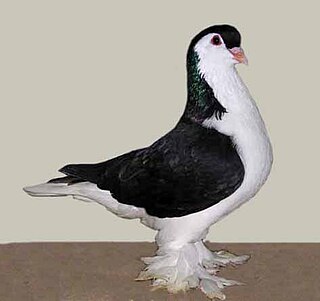
The Lahore is a breed of fancy pigeon known for its impressive size and gentle nature. Lahores, along with other varieties of domesticated pigeons, are all descendants of the rock pigeon.
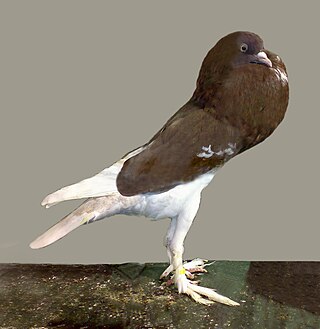
The English Pouter is a breed of fancy pigeon developed over many years of selective breeding. English Pouters, along with other varieties of domesticated pigeons, are all descendants from the rock pigeon. A breed with an enlarged crop, their distinctiveness was described by Charles Darwin in The Variation of Animals and Plants Under Domestication (1868).

The African Owl is a breed of fancy pigeon developed over many years of selective breeding. They originated in Tunisia (Africa), and were imported into England during the 19th century. The breed is known for its short beak, which gives the breed the "Owl" name due to the size and shape.

The Komorn Tumbler is a breed of fancy pigeon developed over many years of selective breeding. The breed has American and European varieties that are recognized as separate breeds at shows with classes catering for American Komorner Tumblers and European Komorner Tumblers. Originally bred for acrobatic flying as a tumbler pigeon, Komorners are seldom free-flown today, and exist only for exhibition in pigeon shows.

The Indian Fantail is a breed of fancy pigeon developed over many years of selective breeding. Indian Fantails, along with other varieties of domesticated pigeons are all descendants of the rock dove.
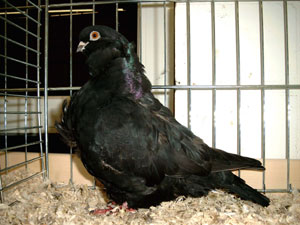
The Chinese Owl is a breed of fancy pigeon developed over many years of selective breeding. Chinese Owls, along with other varieties of domesticated pigeons, are all descendants from the rock pigeon. The breed is known for its small size and profuse frilled feathers. Many specimens of this breed have a 'chin-crest' around the frontal region of its neck - it does not extend around to the back of the head. The feathers are more 'ruffled'and appear 'wind-swept' rather that 'curled' as in the frill varieties. The breed comes in many colors : black, brown, blue/ blue-grey, barred, ice, satinette blondinette, white, pied and white-black (combinations).

The Old German Cropper is a breed of fancy pigeon developed over many years of selective breeding. Old German Croppers, along with other varieties of domesticated pigeons, are all descendants from the rock pigeon.

The Italian Owl is one of the many breeds of fancy pigeons developed over years, often decades, of selective breeding. Like other breeds of fancy pigeons, Italian Owls are descendants of the domesticated rock pigeon. Italian Owls are noted for their proud horizontal stance, relatively small size compared with many other fancy breeds, broad and rounded breast that displays a prominent chest frill, a somewhat flat head that is rounded at the front and back, a rather short tail, and orange eyes unless a bird is white or pied, in which cases the eyes are "bull" (black). Healthy Italian Owls are perky birds that stand on their toes and give the appearance that they are ready to spring forward. The breed is represented in the United States by the Valencian Figurita and Italian Owl Club, and in Germany by the Sonderverein der Züchter Italienische Mövchen. Italian Owls are bred in many beautiful colors. These include blue, silver, red, and yellow in the major three patterns of check, barred and bar-less; recessive reds, yellows and whites ; spread blacks ; pied in the major colors and in various patterns; gold-collared birds in the major colors and patterns; grizzle; and almond, andalusian and indigo. Photographs of the breed in these various colors and lists of breeders can be found at the speciality club web sites.

The Jacobin is a breed of fancy pigeon developed over many years of selective breeding that originated in Asia. Jacobins, along with other varieties of domesticated pigeons, are all descendants of the rock pigeon. It is in the Asian feather and voice pigeon show group. The breed is known for its feathered hood over its head.

The Ice pigeon is a breed of fancy pigeon developed over many years of selective breeding. Ice pigeons, along with other varieties of domesticated pigeons, are all descendants from the rock pigeon.
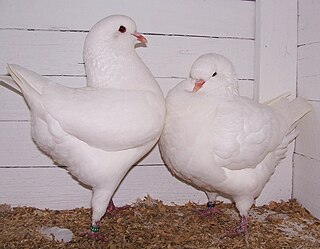
The King pigeon is a breed of pigeon developed over many years of selective breeding primarily as a utility breed. Kings along with other varieties of domesticated pigeons are all descendants from the rock dove.
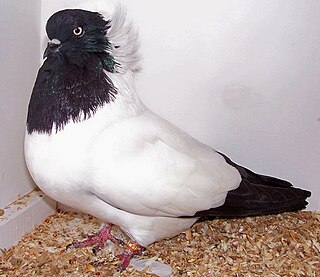
The Nun is a breed of fancy pigeon developed through many years of selective breeding. It was known as the Dutch Shell Pigeon in continental Europe. Nuns, along with other varieties of domesticated pigeons, are all descendants from the rock pigeon . The Nun is one of the oldest breeds and was originally a flying tumbler before being developed for exhibition. It is a mostly white breed, with a hood of feathers, which gives the name to the breed.
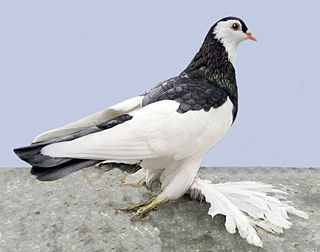
The Australian Saddleback Tumbler is a breed of fancy pigeon developed over many years of selective breeding. Australian Saddleback Tumblers, along with other varieties of domesticated pigeons, are all descendants of the rock pigeon . As the name suggests, this breed is an Australian creation and was first recognized as a breed in 1917.
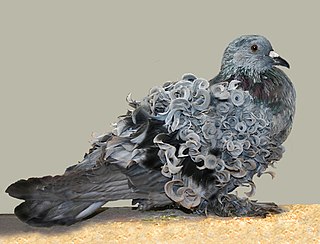
The Frillback is a breed of pigeon developed over many years of selective breeding. Frillbacks, along with other varieties of domesticated pigeons, are all descendants from the rock pigeon. The breed is known for the frill or curls on the wing shield feathers. The feather curl should also be present at the ends of the foot feathers or muffs.

The Danish Suabian is a breed of fancy pigeon, developed over many years of selective breeding. Danish Suabians, along with other varieties of domesticated pigeons, are all descendants from the rock pigeon . The breed comes in silver, blue, ash yellow, ash red, black, red, yellow, and brown barred and is either plain-head or peak crested.

The Reverse-wing Pouter is a breed of fancy pigeon developed over many years of selective breeding. Reverse-wing Pouters, along with other varieties of domesticated pigeons, are all descendants from the rock pigeon . The breed is known for its eye-catching markings.


















